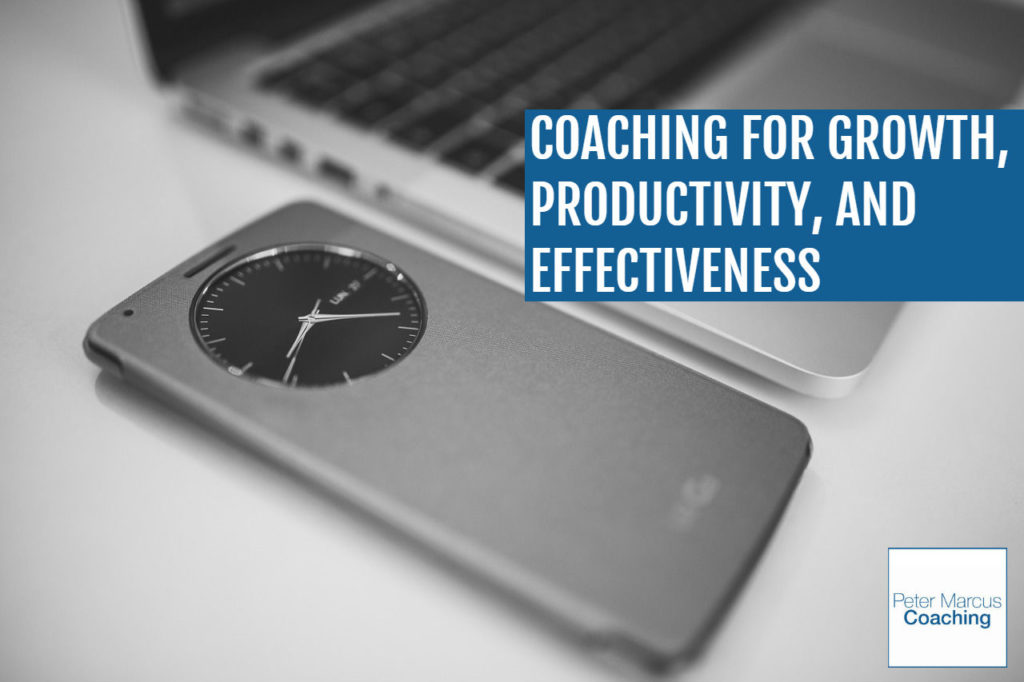Coaching for growth, productivity, and effectiveness

Growth is a factor every business strives to achieve, but most business owners do not know how to attain and sustain growth. Often, if your organization does not understand the intricacies of maintaining its foundations, its development may halt to a standstill.
This is an obstacle that many businesses have trouble overcoming. How do you avoid the pitfalls and mistakes that can potentially stunt the productivity and effectiveness of your organization?
Here at Peter Marcus Coaching, we want to help you explore the intersections between growth, productivity, and effectiveness, and how it can really affect your business. You will be given the opportunity to learn how these concepts can build off each other to maximize your company’s potential in an organic manner.
Growth
What is growth in business? How do you define and measure it? If you ask entrepreneurs or business owners, you are likely to hear: “revenues and profitability.” However, to gain revenue growth, you may consider figuring out what exactly needs to be achieved to advance on those goals.
There is much more to growth than financial benefits.To achieve those financial gains, your business requires related growth goals such as how the market sees you, the knowledge base of your company, and leadership capacity.
Plan for growth
In planning for growth, what is the mindset to adopt? What is an attitude you may choose to cultivate in your organization? Does it involve the measure of productivity? How will you gauge the growth in how effective your teams are?
A simple answer could be excitement. Excitement in one’s work is significant for the increase in productivity and effectiveness in a business. It can generate a ripple effect throughout a company, driving employees to utilize their best skills to propel the business forward in a high-growth company.
Barriers to growth, productivity, and effectiveness
As you gain momentum with growth, losing momentum may be avoided through the intentional acknowledgment and planning to grow through these known hurdles:
Isolation
Many company employees experience the barrier of isolation at times – the feeling of being alone within a team or project. This growth inhibitor lurks around individuals that need to be assigned to a particular project. Due to the nature of the project, they may feel isolated without any assistance or leadership from anyone else. Fortunately, there are methodologies to deal with this, such as:
- Regular check-ins. A routine checkup of how each person is doing and how each team is doing is vital in maintaining accountability with individuals on specific projects. Consider conducting these check-ins sparingly as you do not want to come across as a micro-manager.
- Asking questions. You can choose to ask specific questions to make sure people do not feel alone or detached from the organization. Prepare emotion-based questions such as asking about their frustrations, as well as the goals that were reached or not reached, and why. This allows you to avoid breakdowns in communication.
Scarcity
Businesses grow, but people on your team may begin to feel isolated and with that, get overprotective of their work and their role within your company. A shortage mindset cannot be allowed, if you are expecting completion. Instead, an attitude of abundance is a choice that can be implemented, so that the scarcity approach can be replaced. It is vital to recognize and coach your team that as growth happens, there will be more time and resources to focus on other subjects and areas that have the capacity for further growth.
Loss of vision or culture
In a small team, the company’s values and culture are obvious. But as the team grows, there are some methodologies to consider:
- Clarifying the Why; what is the ultimate why to what we do. Remember, the bigger the Why, the easier the How.
- Define a series of or a definitive purpose or goal. Be clear of your objectives.
- Paint a clear picture of the impact those goals will have on the organization.
- Be clear about the organization’s values, especially when it comes to recruitment of new staff.
- Appraisal, how will you assess your new recruits?
How do you know your company is ready for a growth strategy?
As an owner, you can assess whether your business is ready for growth. Are you considering a strategy development program? Do you even have a plan ready? There are many questions that you can consider, but mainly, preparedness starts with these observations of your team:
- Are people saying, “That is not my job”?
- Are there strategies to measure accountability with your team?
- Is there fear amongst your team members?
- Are people speaking the truth or are there facts being held back during meetings?
- How is your leadership showing up in presenting this chosen growth strategy?
If the above questions are met with positive responses from your team, that is only the first phase. There is much more work to be completed before you can implement a growth plan.
The BusinessLife methodology of caring for that is by you providing clarity, and with that, by sharing your top three results that you are expecting your teams and individuals to deliver. By choosing to build cross-functional teams, such as encouraging people to learn more about other departments, utilizing effective team meetings, and working on the opportunities and the potential and real problems together, you are more likely to successfully implement a growth strategy that is sustainable.
Coaching for growth, productivity, and effectiveness
Growth, productivity, and effectiveness are all interconnected – it’s hard to have one without the other two. To fully immerse your organization into a growth plan, it is important to be aware of asking questions as a way to check in on your business and employees.
There is a delicate balance for you to achieve as an owner. Your job is to keep a finger on the pulse of your business growth, but overdoing shows up as micromanaging your leadership team and will have a reverse effect on your business’ growth. The key is to maintain a coaching attitude as an owner, do not be a dictator to the productivity and effectiveness of your team members. Ownership is a gift, choose to be grateful.


